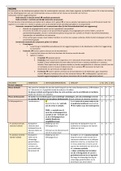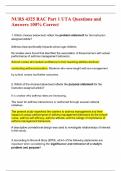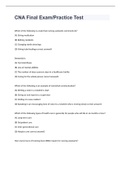HY113 – Revision notes
Topic 1 - India in Revolt
Readings…
1. A concise history of India - Metcalf, Barbara Daly, Metcalf, Thomas R. 2001
Essential Chapters 6 and 7.
1919
- Montagu Chelmsford Reforms – they withheld idea of Swaraj (self rule) but Indians would want
more.
- Also Rowlatt Act and the Amritsar Massacre, people chose political action in the form of ‘non –
violent non-cooperation’
- Gandhi would become lasting symbol of moral leadership for the community
Reform and Repression
- 1917 Montagu announced objective of British rule in India would be the ‘gradual development of
self governing institutions – leading to independence, British would put faith in educated minority
to carry on rule – “intellectually our children” (Montagu), Britain would ensure pace of reform was
slow and measured
- British formulated dyrchy in first step to self - government - split functions of government into two
(central government in New Delhi remained under British control entirely), in the provinces some
areas e.g. agriculture, education, resp for raising taxes were transferred to Indian ministers
responsible to local legislatures.
- Reforms may have been accepted, but accompanied by coercion on the part of the British – Rowlatt
Acts, continues powers of detention and trial without jury, - aroused an intense hostility among
Indians
- In response Indians protested – nation wide hartal (work stoppage), linked to marches in major
cities – so effective were these that the government introduced martial law in some areas.
- Jallianwalla Bagh – fired 370 protestors lay dead and over 1,000 were wounded, isolated incident
but became a symbol of colonial injustice – Indians not capable of governing themselves – British
thought
Advent of Gandhi
- Loss of faith in British intentions after massacre – Gandhi – architect of India’s independence, most
original and influential thinkers of the twentieth century
- Gandhi – new courage in non – violence and passive resistance – transformed into strength,
criticism of western obsession with material goods, purchase of English goods and industrial
development had to be avoided, machinery is the chief symbol of modern civilization – it
represents a great sin.
- In its place, idea of a simple life based in a society, traditional Indian village, each member looks
after one another, true independence not just getting rid of British but changing society from
bottom up, people realizing their spiritual worth, moral not simply political transformation of
society, because of this he could not justify that any means could be used to bring about freedom,
included not only Indians from wealthy zamindar to untouchable but the British as well and
included Muslim, Hindu, Christian
- Abandoned passive resistance for satyagraha (truth force) – disciplining of the passions and an
avoidance of violence (vegetarianism – avoided violence to animals and also meant that he ate –
passion), abstinence from sexual relations even when married and promoted simplicity of dress –
hand spun fabrics (khadi) – every nationalist expected to spend a certain no of hours at the
spinning wheel.
- Gandhi never offered wholesale repudiation of the Hindu caste system, much as he tried to ease
tensions among groups he spoke always with the patronizing assurance of the upper-caste Hindu.
, - He never claimed to speak for Hinduism but he sought to build a coalition among religious
communities. However, his manner, dress and vocabulary were suffused with Hinduism – so
religion in this view formed the binding glue of the nation – turned this to political advantage
- In a largely pre-literate society, much appeal of Gandhi lay in visual symbolism – travelled like an
ordinary peasant, third class railway, wearing the loin cloth of the Hindu holy man, every station
stop he would speak at a mass rally – images appeared as news reports/media became more
pervasive
- Offered the educated elite a critical reassurance. Congress leadership were not Marxist and with
Gandhi they had a leader who appealed to those outside the constituency of the educated and yet
would not threaten their own predominance in society.
The Power of Gandhi’s Name – Supporters and Opponents
- His appeal across India was never uniform
- Gandhi secured Congress approval of non – cooperation by forming an alliance with the Muslim
supporters of the Ottoman Khilafat – without their support non-cooperation motion of Sep 1920
Congress would have been defeated. But Khilafatists were organized separately under their own
leaders and had own priorities
- Main supporters were in his home – province of Gujarat, - even the wealthiest Gujarati traders and
industrialists supported his activities, (you would think they would be opposed to his hand –
spinning utopia) – they shared caste and regional values with Gandhi and their manufacturing
enterprises would profit from swadeshi production
- Outside Gujarat – professional elite and trading community supported him and the more
substantial peasantry – but commitment to Gandhi differed – Nehru wanted a modern India which
would hold its own against the West, Nehru even thought socialism was a good idea as he saw
socialist Russia as having a model of economic development.
- Among impoverished peasantry Gandhi’s message not clearly understood – peasants of UP looting
bazaars, attacking landlords, Feb 1922 peasant mob in Chauri Chaura, locked 22 Indian policemen
in the local police station and set the building on fire, v little support for non-cooperation among
some groups.
- Lowest elements of social order – artisans and landless, remained outside – railways and
newspapers also rarely penetrated certain areas and also princes sustained power by the British
since 1858 were determined to keep nationalism away from their states.
- Most intense opposition, those who had led congress before 1920, educated elite of Calcutta,
Bombay and madras – threatened by Gujarati and non – cooperation e.g. Bengal Bhadralok enjoyed
benefits from involvement in law courts and legislative councils and didn’t want to give this up –
C.R. Das head of Bengal congress joined Gandhi at last minute in 1920 when he could not defeat
non – cooperation programme.
- M.A. Jinnah resigned from congress and turned to Muslim league rather than support unseemly
mass movement suffused with religious symbols
- In Punjab and Madras, provincial caste and class antagonisms restricted Gandhi’s base of support –
kept unionists in power till mid-1940’s
- In Tamil areas of South – Brahman community championed nationalist cause, suspicious non –
Brahmans saw no point in exchanging British dominance for Brahman dominance – antagonized by
Gandhi’s preaching of Hindi as a national language – non – Brahman landlords organized the Justice
Party – in 1920’s in particular worked with the British to secure larger government share and
university places for their community
- India’s Muslims feared the independence of the Ottoman Sultan (his position sustained law and
faith of Muslim’s everywhere) – fear prompted meetings and protest marches – helped define
emerging identity of ‘Indian Muslims’ – British harsh sanctions against turkey led to large numbers
of Muslims (conservative and western educated) being closer to Gandhi – British deserved
condemnation for treatment to India and Turkey but All India Khilafat Committee remained
separate entity to Gandhi’s
, - The Jamait imagined India composed of two separate communities – Hindus and Muslim’s – each
with own law, courts and education system – despite anti – colonial stance they paid little attention
to Gandhi’s ideals, though they were separated in India and divided they lived in self-imposed
isolation to Gandhi and his ideals
- (HISTORIOGRAPHY) Indian nationalists (in years since 47) often look at the Congress – Khilafat
alliance nostalgically, road that should have been taken but alliance only lasted 1916 and 1922 and
though harmonious, the distinctions between communities were not broken down. – Often used
religion as a distinguishing feature e.g. Khilafatists flag had Muslim crescent, Montagu-Chelmsford
reforms made antagonisms worse and so did increased use of religious symbols – created further
separation and era of rioting and recrimination
The Course of Non – Cooperation – Gandhi adopted to take moral high ground and make British feel as
though they were violating their own principles by using force against peaceful protestors
- For British – dilemma, had strategies in place to control nationalists, moderate – conciliated or
ignored, extremists – jail, but non – cooperation was different – didn’t know how to respond
- Indian government wanted to get support for dyarchy, didn’t want to risk by being repressive (no
repeat of Amritsar massacre), also to jail a large no of peaceful protestors would make British look
like bullies in the eyes of the world and even to themselves
- For British 1920’s Indian market crucial for British exports, British also did not trust Gandhi (“half
naked fakir” – Churchill – resonated much British opinion)
- British had to act gently so Gandhi not seen as martyr but forceful enough for people to see fate
rested in their own hands not Gandhi, not arrested during non co-operation of 1920-22, arrested
after Chauri Chaura killings when Indians started to give up on non-cooperation – in this way British
kept control of devolution of power, were able to keep nationalism under control, aftermath of
Chauri Chaura reassured them that Gandhi was still committed to a course of non – violence –
made credible the policy of mild restraint than force
- British did have lathi charges and mass arrests, but mostly British and congress did have a
relationship e.g. in prison congress leaders allowed books, visitors and food not permitted to other
prisoners
- Gandhi by plead guilty he embraced British notions of justice in a way that showed he was
prepared to make sacrifices for the good of others
- 1920’s, 30’s and 40’s – 3 major cycles beginning with British action
- 1922 after non – cooperation movement, members of congress (Nehru and C.R.Das) formed break
away Swarajist Party, similarly Khadi movement took an organizational form through all India
Spinners Association, - important as wearer of this usually white cloth defined as a member of a
universal Indian nation. – Khadi constructed an India that was united, disciplined and cohesive, also
created new opportunities for women who participated actively in the creation of the nation, to
Gandhi Khadi “binds all brothers and sisters of India into one” – visual power is seen by comparing
congress meeting in 1919 (western clothes dominate) to 1924 (Khadi movement dominates),
however, upper class women didn’t like giving up saris for cloth associated with prostitutes, widows
and the impoverished, Nehru even sought a compromise by use of textured fabrics.
Agrarian and Industrial Upheavals
- Post war years – class based protests movements increase, 1917 – 20 – price levels rose by nearly
50%,, price of staple foods rising more than higher quality, along with poor monsoon and influenza
pandemic in 1918, hardships = protest
- Peasant society movements of 1920 -22 in the UP and Bihar, movement sought to put peasant not
nationalist interests at the top of the agenda – riotous demonstrations on landlord properties,
sometimes attacked bazaars to secure fixed prices for basic commodities.
- Residents of Himalayan foothills expressed their grievances by breaking into reserved forests and
setting them on fire – little came of peasant protests – only propelled the landlords into the
political arena – national agriculturists Party took office under the dyarchy constitution in the UP –
Congress offered but little more support to the peasants than the British
, - Nehru – never set foot in village before in 1920 described his sympathy and opinion that more
equitable distribution of wealth was essential to full independence but frequently in jail never
offered leadership in the countryside, Gandhi also hostile to class-based agitation, prepared only to
countenance rural struggle only when it was directed against the British.
- When class was not pitted against class, all could work together on behalf of the anti-colonial
struggle.
- Factory labour after war – strikes and rise of India’s first TU, middle class congress leadership
unable to restrain the militancy of those on the shop floor – labour organizing – opp for
communists, inspired by success of 1917 Bolsh Rev, M.N. Roy established the communist party of
India in 1928 Bombay textile workers strike for over 6 months over wage cuts – aftermath Girni
Kamgar Union created – at height had 60,000 members – successes short lived, gov repression
fierce – conspiracy trial in 1929 – all major communist leaders put in prison for over 4 years. –
never able to penetrate countryside, v little success
- Also enduring populism different to official nationalism – used visual imagery (posters, prints) and
matyred heroes e.g Bhagat Singh – killed british officer in 1928 and months later threw bombs into
a legislative chamber – convicted and hanged, achieved fame through mimicry of British dress and
manners – undetected for some time. Antithesis of Gandhi and both Gandhi and British wanted to
suppress such nature.
Non – Cooperation: Round Two, 1927-34
- 1927 – British commission – Indians incapable of deciding their own fate, still children needed all
knowing parents to legislate for them – set scene for next non – cooperation phase, no timetable
for independence still
- Lord Irwin implied Britain had relinquished any hope of retaining long lasting authority over Indians,
1930 British convened a series of round table conferences in London
- Nehru report (1928) – immediate independence and federal India much like the one emerged after
1947 – reignited suspicion of a Hindu Raj and united most Muslim political leaders, apart form a
few nationalist Muslims in opposition to congress. Jinah e.g. wanted relative autonomy for the
Muslim majority provinces
- In these years no vision of a separate Muslim state, Muslim leaders just wanted to protect the
interests of India’s Muslims – 1930s Khilafat leader described how he belonged to two circles –
India and the Muslim world and that he could leave neither
- Gandhi – 1930, 240-mile march from his ashram to the sea, followed by illicit manufacture of salt –
salt march brought Gandhi to public notice in US and showed confrontation of British imperialism
over access to a basic commodity, increased visual effects by clad of Khadi demonstrators
(including women), arrested Gandhi but damage done – civil disobedience movement spread
rapidly throughout India, enhanced by great depression – prices fell
- Second campaign – groups that had not previously participated, women came out, protests against
forest regulations took place, movement among Muslim Pathans allied with Gandhi on northwest
frontier. – Apart from here though Muslim participation was limited compared to 1920’s.
- 1920’s – South India aloof to nationalism but by 1930’s with non –Brahmans securing more places
in government and universities, Justice Party and secured their goal and Tamil poets and
intellectuals at the same time helped create an increasingly self-confident south Indian culture –
neither nationalism nor Gandhi were as threatening
- Confronted with popular appeal, British began to fear an ebbing away of authority at the hands of
Congress also Gandhi-Irwin pact and Gandhi attending second round table conference secured little
for British but showed congress had gained an unprecedented legitimacy as the representative of
Indian nation – but pact collapsed in 1932 new viceroy Lord Wilingdon cracked down on congress –
some 40,000 Indians were arrested within three months with many, inc Gandhi, in jail for two
years.
New Opportunities, and New Conflicts
- British bring India’s princes into the political system – seen as the ideal representatives of the
‘feudal’ India the British had created to assure their predominance












